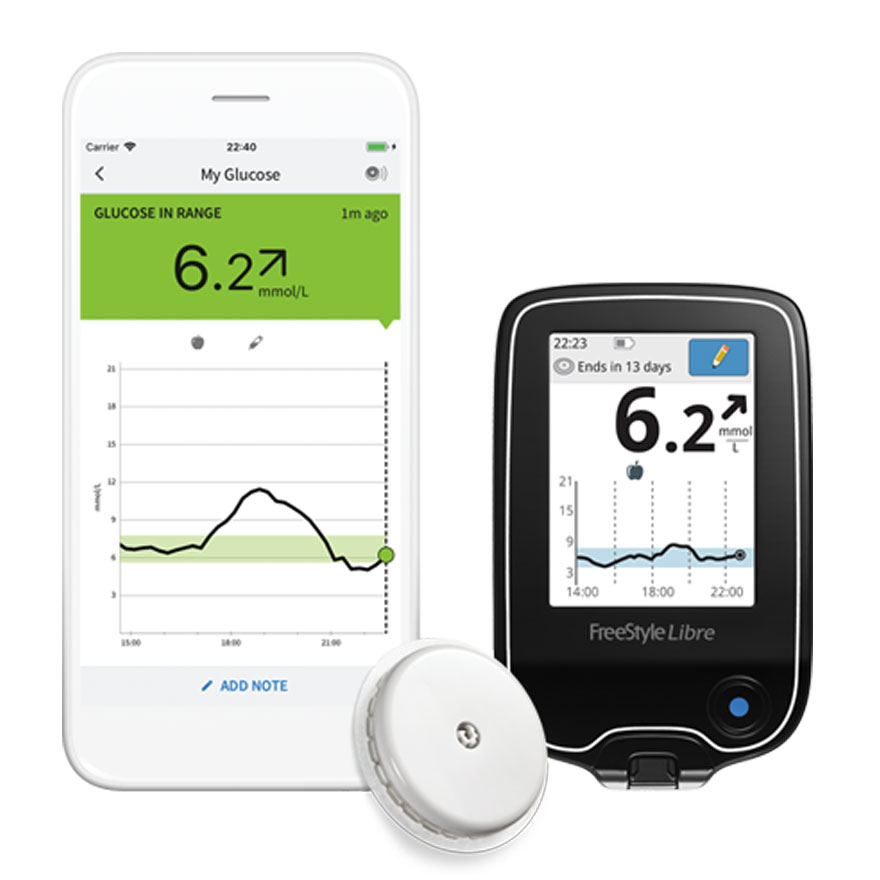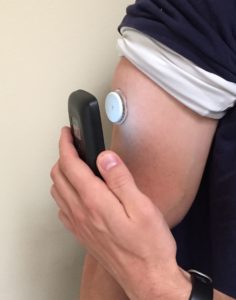Posts Tagged ‘Continuous Glucose Monitors’
A Quick Guide for the FreeStyle Libre System. By Our Student Pharmacist, Prutha Patel.
What is CGM? How is it different from BGM?
Continuous glucose monitoring (CGM) automatically tracks blood sugar levels throughout the day and night. A small sensor is placed under the skin which tests the sugar levels in the interstitial fluid. Through CGM, you can see changes and trends in your blood sugar over time which can help get a better handle on your diabetes.
On the other hand, blood glucose monitoring (BGM) tests sugar levels in the blood through fingersticks and measures your glucose levels at a single moment in time.
FreeStyle Libre System Overview
The FreeStyle Libre System is a continuous blood glucose monitoring device for people with Type I and Type II diabetes. A small sensor is placed on the back of the arm and can be scanned with a reader or app on your phone to see real time glucose levels and trends in your glucose levels.
FreeStyle Libre Sensor
The FreeStyle Libre Sensor is a small device about the size of two stacked quarters. The filament on the sensor is less than 0.4 mm thick and goes into the interstitial fluid, a thin layer of fluid below the skin.
How do I put the sensor on?
- Choose an area on the back of the upper arm that is free of any moles, scars, or recent insulin injections.
- Peel the lid off completely from the sensor pack. Unscrew the cap of the sensor applicator and set aside.
- Line up the dark mark on the sensor applicator with the dark mark on the sensor pack. On a hard surface, press down firmly on the sensor applicator until it comes to a stop.
- Place the sensor applicator over the chosen site on the arm and press down firmly until the sensor is securely in place.
- Recap the sensor applicator and discard sensor pack and applicator as appropriate.
Here is a quick link to a video by FreeStyle US: How to Apply the Sensor
Once the sensor is in place, it has a one hour warm up time before any glucose readings can be obtained and the sensor is worn for 14 days then replaced with a new sensor.
The sensor is water resistant up to one meter of water for 30 minutes and can be worn while showering and exercising.
The sensor should be removed prior to MRI, CT scans, X-rays, and diathermy treatments. Additionally, it should be removed for airport security if you are going through the full body scanner. To remove the sensor, gently pull up the edge of the adhesive of the sensor and peel off in one swift motion. It is important to note that the same sensor should not be replaced on skin if it falls off or has to be removed before the 14 days are up. If the sensor falls off early, patients may call the Abbott Diabetes Care line at 1-855-632-8658 for further assistance.
FreeStyle Libre Reader and LibreLink App
The FreeStyle Libre Reader is a small, chargeable device that is used to scan the FreeStyle Libre Sensor to retrieve glucose levels and trends over time. The reader is held close to the sensor and a small sound or vibration will alert you that data has been collected. One sensor at a time can be paired to a reader and the reader will tell you how many days are remaining on the sensor. It will display an alert when three days are remaining, and when eight hours are remaining. The Reader also contains a port for test strips to check blood sugar levels when a check blood sugar symbol is displayed. The port on the Reader is compatible with the FreeStyle Precision Neo test strips.
What does the reader tell me?
- Visual alerts and trend arrows → alerts when glucose levels are getting high, and shows current glucose reading
- Daily patterns graph
- Time in target chart
- Average glucose graph
- Low glucose events graph
Data is stored on the reader for up to 90 days and reports are available to 7, 14, 30 and 90 days.
FreeStyle LibreLink App
The FreeStyle LibreLink App is an app that allows you to use your smartphone to scan your FreeStyle Libre Sensor similar to the Reader. When you open the app, you hold your phone close to your sensor to get a reading. A small tone or vibration will alert you that the data has been transmitted which you can then view in the app. In the app, you can view your current glucose reading, see how your levels are changing, see glucose history from the last eight hours, and add notes to track food, insulin doses and exercise. The FreeStyle LibreLink App is available to download on the Apple App Store and on Google Play.
References:
https://www.freestylelibre.us/system-overview/freestyle-14-day.html
https://www.freestylelibre.us/support/faq.html
https://www.freestylelibre.us/system-overview/continous-glucose-monitor-app.html
Continuous Glucose Monitors, a Pharmacy Perspective. By Our January Student Pharmacist, Brayson Ramirez.
Checking blood sugar with finger sticks throughout the day may not be the worst part of diabetes, but it is possibly the most well-known. Finger sticks always have discomfort associated with them and nobody likes to poke themselves to draw blood, no matter how small the sample. The ability to test blood sugar without having a finger stick sounds like a dream solution to a problem affecting such a large number of people. Continuous glucose monitors, or CGMs for short, are trying to offer this option.
Recently a new product has come to the market and has been gaining popularity in this area, but why? Continuous glucose monitors have been around for a while, but lancets and test strips have not gone away. I wanted to take this chance to look at the continuous glucose monitors from a pharmacy perspective.
There are a couple of very important variables with CGMs that are commonly not considered or well-advertised. The first is the warm-up period of the monitor system. During this time, the sensors are not guaranteed to produce accurate data, so it would not be recommended to use those readings for insulin administration or glucose record keeping.
The second variable is the calibration of the sensors as recommended by the manufacturer. In order to have the most accurate readings, calibration is required. To calibrate a sensor, a traditional finger stick reading is required. In some cases, the calibration finger sticks may be even more poking and prodding than a traditional blood glucose testing schedule.
I went through some of the more popular CGMs and made a quick summary chart of their warm-up and calibration requirements along with their life span. The products listed do not include insulin pumps that can integrate with sensors to get glucose readings.
As you can see from the chart, the Freestyle Libre system is the only one that does not require the user to calibrate, so it is the most likely to reduce finger sticks. All of the systems require a warm-up period. Again, the Freestyle Libre does show a bit of an improvement in this area. It has a one hour warm-up time, but it has a sensor life of 14 days, so that warm-up time will be coming around less frequently.
When it comes to accuracy with continuous glucose monitors and traditional blood glucose meters, it is very important to understand how each works. Blood glucose meters are basically taking a snapshot of your current glucose level. CGMs measure glucose levels with interstitial glucose that is basically leaking out of your blood vessels, as seen in the above image. Since the interstitial glucose is not a direct measurement of blood glucose, the values are more like delayed blood glucose levels. With this delay, CGMs are not the best in a situation where glucose is rapidly changing, such as a severe high or low glucose reading that you are trying to recover from. In those cases, finger stick glucose readings are going to be more accurate and potentially avoid an even more serious situation.
Continuous glucose monitors have been shown to produce better outcomes overall for diabetic patients due to their more constant monitoring, but it is still necessary to keep a supply of traditional testing supplies for emergencies or sensor malfunctions.






